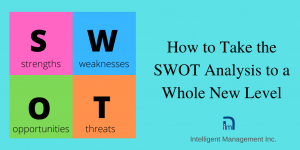
This week, a client of ours drew up a SWOT analysis and it turned out to be a very productive event. The SWOT analysis tool has been around for a very long time. The Strengths, Weaknesses, Opportunities, Threats categories are comfortably familiar to many as a way of brainstorming and analyzing the current reality of a company (or project) for a variety of reasons, like marketing or strategy.
SWOT is not something that we would normally use at Intelligent Management and there’s a reason for that. Dividing elements up into the 4 categories is a linear thinking exercise. It is not systemic and that means it misses the big picture. Why? Because it looks at the elements as separate when what is most important is how they are connected or interdepend. We can’t see those connections when we put them into the SWOT boxes. All we have is a shopping list.
However, what we saw this week was that SWOT was still a way of gathering information that we could then process with a much more effective systemic Thinking Process. The items the client listed under ” Threats” and “Weaknesses” were essentially what we call in the Theory of Constraints “Undesirable Effects”. These are hugely important because they are like “symptoms” that can help us identify something deeper that needs to be addressed. For this we need more than a “tool”. We need a systemic Thinking Process that helps create new synapses and opens up new possibilities.
From negative to positive
The beauty of the Core Conflict Thinking Process is that it takes something that seems negative – what’s not right, what is causing pain and is “undesirable”– and transforms it into precious raw material that we process to find a systemic solution. The steps involved in building a Core Conflict are structured and clear. The challenge lies in being completely open and honest about what’s not right and having the courage to challenge our habitual thinking.
Once we have a list of Undesirable Effects (UDEs)and this can also be achieved as we have seen using a SWOT analysis if that helps, these Undesirable Effects are summarized into one, overarching Undesirable Effect that sums up the current, unsatisfactory reality. We then verbalize the “conflicting position”, in other words, what a desirable reality would look like. We call these positions in the conflict cloud D and D’. These become the two conflicting positions D and D’ of the ‘Core Conflict Cloud’.

Figure shows positions D and D’ in the Core Conflict
The reason these two conflicting positions exist is because they are an attempt to protect two profound and legitimate needs that drive every organization: the need for control and the need for vision. We state the need for “control” that forces us to accept or to cope with D; we call it B. Then we state the need for “vision” that prompts us to say that D’ is the reality we would like to live in; we call it C.
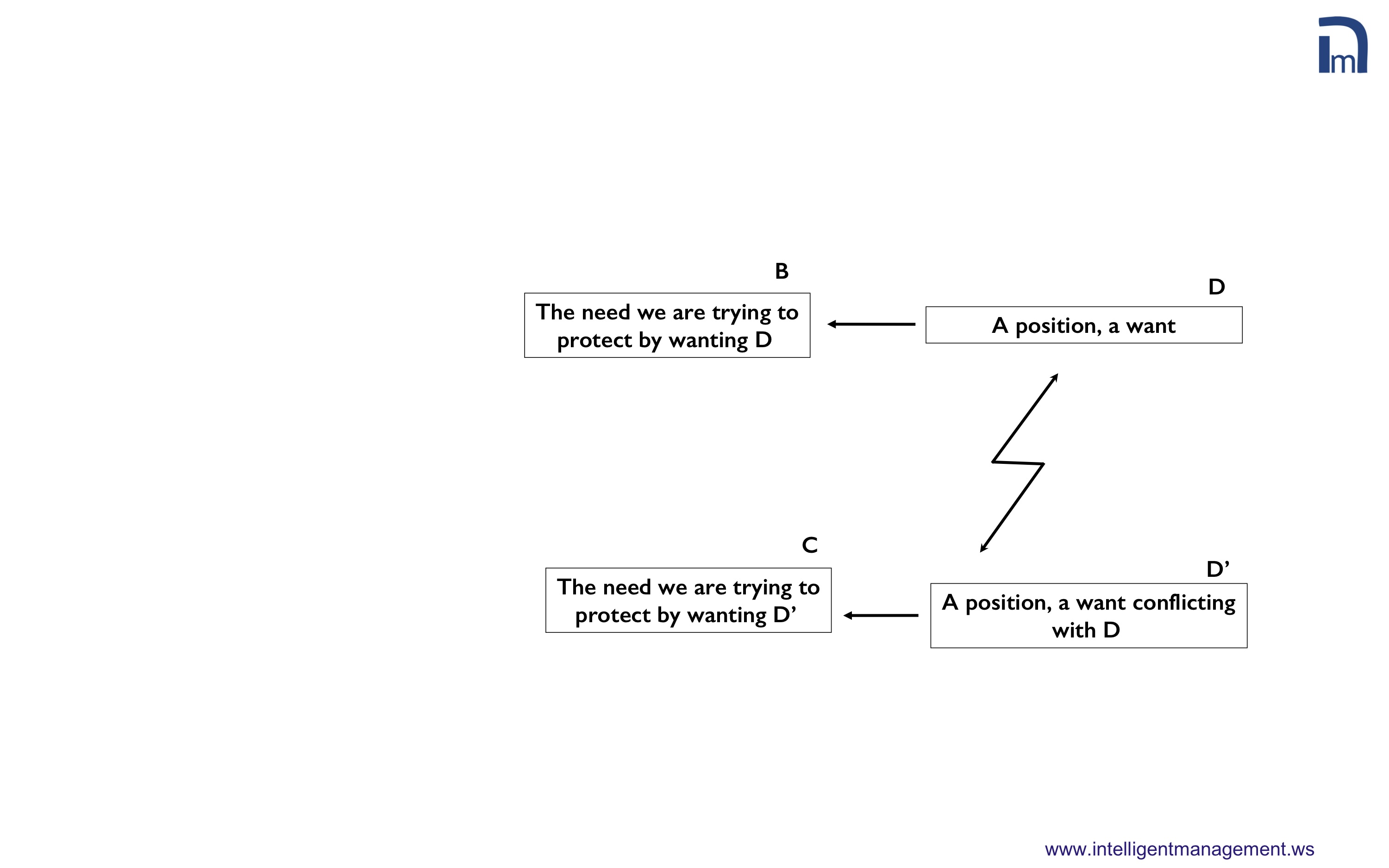
Figure shows the needs B and C
Once these needs are precisely verbalized, the organization can then derive the common goal that satisfies those needs, thus providing an organic direction rather than artificially imposing a goal (A). The needs B and C must be simultaneously satisfied in order to achieve the goal in A.
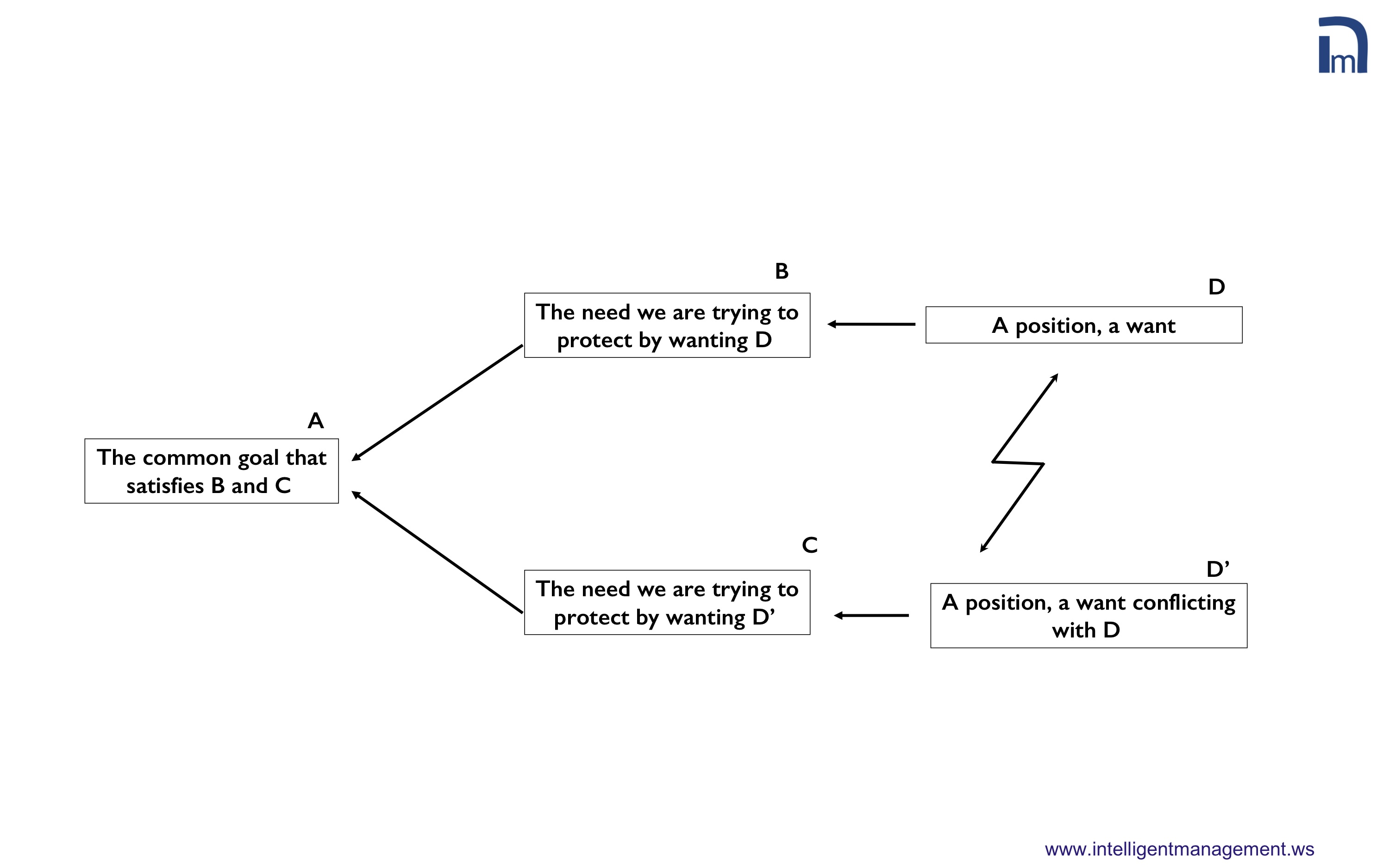
Figure shows the Core Conflict Cloud with positions, needs and goal
Summarizing all the UDEs in one single statement is normally a little cumbersome but it is generally done in a few hours. At this point the procedure of identifying the desired reality, needs and goal begins and the end result is normally welcomed as a breakthrough. How does that breakthrough happen?
Challenging our assumptions to achieve breakthrough
The conflict cloud helps to sharpen our intuition. In just a few days the group of executives/managers has moved from an often disparate set of non-verbalized hunches to a clear cut picture of the forces that keep them from achieving their goal. Moreover, a precise description of the needs that craft the psyche of the organization goes a long way towards helping to understand the “why” we are trapped in this conflict, i.e. the reason for it. We believe that no top management strategic retreat session delivers a tangible and operational output like this one. Now that the intuition is strong we can make it stronger.
What transforms a Core Conflict into a full-blown picture of our current reality is a disciplined, orderly elucidation of all the mental models that give birth to the conflict. These mental models are deeply rooted images that we have of ourselves and the world around us. These mental models, which we may also call “assumptions”, are the cognitive lenses through which we perceive reality.
Systematically surfacing the assumptions is the most challenging aspect of the Core Conflict cloud because we have to think hard to “smoke them out”. Assumptions are, like any other mental construction, the result of factors that are external (the environment, education, experiences, values, etc.) and internal (the chemistry and physics of our mind). The difference between an assumption and a statement of reality is only the realm of validity and this is determined often by cultural circumstances. A practical example of this would be to take a sentence like “In a democracy every citizen is entitled to decent, affordable and reliable healthcare.” and ask for a comment from a statistically representative sample of individuals in the USA, Canada, and Europe.
Assumptions are the logical connectors between goal, needs and wants; they help us see the logic that shapes the conflict. A conflict with its set of clearly verbalized assumptions portrays the current reality precisely in the way we experience it and is the strongest possible support we can provide to our intuition.
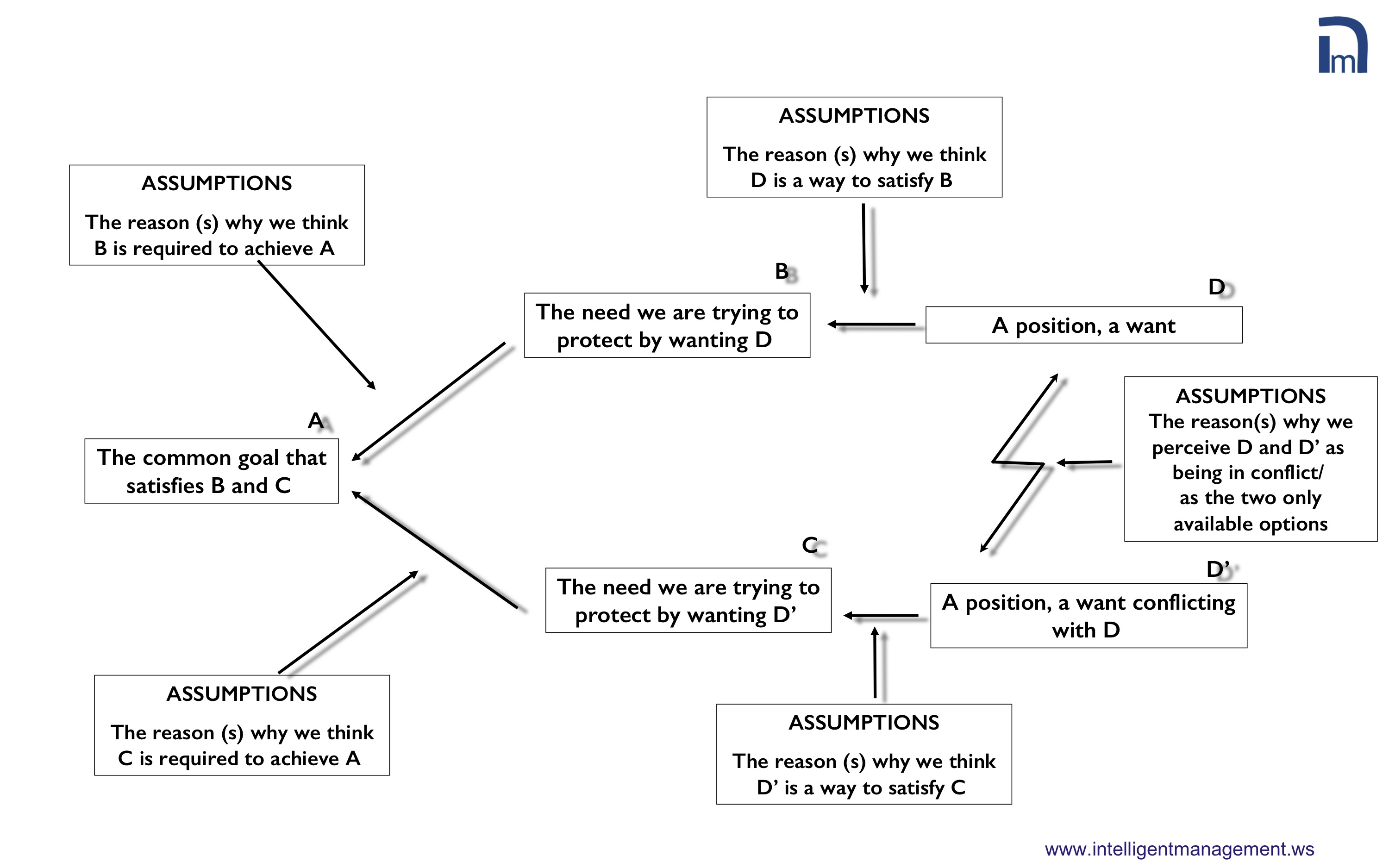
Figure shows Conflict Cloud with assumptions
Goal, needs, wants and assumptions tell us why we are in the current state of reality. But they also pave the way to come out of this reality and move towards a future that is more desirable.
Beyond the comfort zone to the core of the matter
As we said, assumptions are mental models that we have about the world; they are formed as a result of experiences and socio-cultural circumstances. Assumptions are, in every respect, a reality for the person that develops them. These assumptions, particularly the ones that we verbalize between D and D’ in the conflict are, de facto, the constraining element of our reality; they are our cognitive constraint.
Once completed, the Core Conflict Cloud provides us with two essential elements:
1) a profound analysis of what is keeping the organization stuck;
2) a clear verbalization of the goal we desire to accomplish.
This corresponds with the first phase of change: ‘What to change’. See ‘How to Lead Change Management – a Systemic Approach’
When a company decides to take their courage in their hands and really delve into what is keeping them stuck, the Core Conflict Cloud from the Theory of Constraints will take them step-by-step through a thorough and systemic analysis of the problem. The beauty of this Thinking Process is that it contains within it all the elements to identify a successful and practical path to move out of the problem and into the solution.
Schedule an introductory call with us ‘
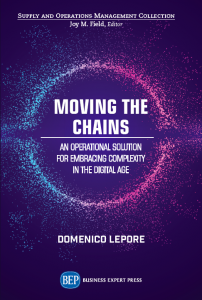





Good, very interesting Angela. I had worked in the past (my past life) with SWOT specially with Quality Standards like ISO 9001:2015 where we need to look for the context of the organization and SWOT was the main tool we use. The idea was to see all the aspects surrounding a system (context) and specially adress with corrective actions the W and T main points. But honestly I had a lot of reservations with this exercise and I found it disconnected between all those 4 letters. But your idea usind the core conflict and the cloud to sistemicly improve this tool seems very clever – I also find all the time applications for this cloud type analysis which are in the core of TOC Thinking Processes.
One thing I did not understand because your fine article is not all the story (there is much more between the lines 🙂 ) was how do you get your UDEs – from the W and T directy ? And what about the O and S ? From your words I would say they are DEs (Desired Effects). If you use the UDEs to get to the core conflict (you didn’t said but maybe you do a CRT- Current Reality Tree) you use DEs when you implement the actions when you invalidade the Assumptions in the cloud, you talked about. So my question is W, T for UDEs and S, O for DEs ?
Good question, Luis! Let’s say that with the UDEs, you have the material to then go on and build the conflict cloud. You can derive from the UDEs the position of D and then D’ and then the needs in B and C and the goal in A. Once you have the context of the cloud, then the other elements of the SWOT analysis will fall more easily into place. For example, the strengths may fall into the assumptions between C and D’ of the cloud and the opportunities may well be intuitions that can be part of the injections.
The categories of the conflict cloud are what equip us with an analysis that we can then take robust action on by continuing with the Thinking Processes (Injections, PRTs and TRTs), unlike the SWOT.